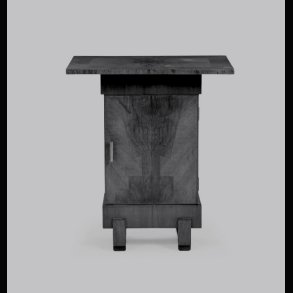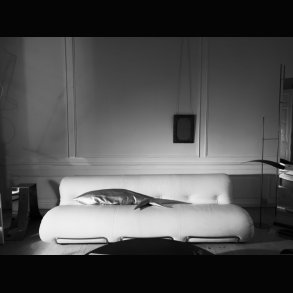DESIGN : JEAN PROUVE . FRANCE . VITRA .
DIMENSION : TRAPEZE SPISEBORD . SORT . 87CM X 321CM. HIGH 72 . LIMITED EDITION
Just like the Antony Chair, Trapèze was originally designed for the Cité Universitaire at Antony. Its name references the table's two strikingly shaped legs made of sheet steel. Together with the tabletop's broad edges beveled outwards, they underscore the construction's solid appearance solidity.
Materials
Base in folded sheet steel, laminate (HPL) tabletop
JEAN PROUVÉ .
> An appreciation of Jean Prouvé is an appreciation of human decency.
Engineer and metalsmith, self-taught designer and architect, manufacturer and teacher .
Prouvé was a key force in the evolution of 20th-century French design, introducing a style that combined economy of means and stylistic chic. Along with his frequent client and collaborator Le Corbosier and others, Prouvé, using his practical skills and his understanding of industrial materials, steered French modernism onto a path that fostered principled, democratic approaches to architecture and design.
Prouvé was born in Nancy . The city with a deep association with the decorative arts. (It is home, for example, to the famed Daum crystal manufactory.)
His father, Victor Prouvé, - was a ceramist and a friend and co-worker of such stars of the Art Nouveau era as glass artist Émile Gallé and furniture maker Louis Majorelle.
Jean Prouvé apprenticed to a blacksmith, studied engineering, and produced ironwork for such greats of French modernism as the architect Robert Mallet-Stevens. In 1931, he opened the firm Atelier Prouvé. There, he perfected techniques in folded metal that resulted in his Standard chair (1934) and other designs aimed at institutions such as schools and hospitals.
During World War II, Prouvé was a member of the French Resistance, and his first postwar efforts were devoted to designing metal pre-fab housing for those left homeless by the conflict.
In the 1950s, Prouvé would unite with Charlotte Perriand and Pierre Jeanneret (Le Corbusier’s cousin) on numerous design projects.
In 1952, he and Perriand and artist Sonia Delaunay created pieces for the Cité Internationale Universitaire foundation in Paris, which included the colorful, segmented bookshelves that are likely Prouvé’s and Perriand’s best-known designs.
The pair also collaborated on 1954’s Antony line of furniture, which again, demonstrated a facility for combining material strength with lightness of form.
Prouvé spent his latter decades mostly as a teacher.
His work has recently won new appreciation: in 2008 the hotelier Andre Balazs purchased at auction (hammer price: just under $5 million) the Maison Tropicale, a 1951 architectural prototype house that could be shipped flat-packed, and was meant for use by Air France employees in the Congo.
Other Prouvé collectors include Brad Pitt, Larry Gagosian, Martha Stewart and the fashion designer Marc Jacobs. The rediscovery of Jean Prouvé — given not only the aesthetic and practical power of his designs, but also the social conscience his work represents — marks one of the signal “good” aspects of collecting vintage 20th century design.
Again to say, > An appreciation of Jean Prouvé is an appreciation of human decency.








